MXA RACE TEST: THE REAL TEST OF THE 2025 HONDA CRF250
 THE GEAR: Jersey: Alpinestars Supertech, Pants: Alpinestars Supertech, Helmet: Alpinestars M10, Goggles: Viral Brand Signature, Boots: Alpinestars Tech 10.
THE GEAR: Jersey: Alpinestars Supertech, Pants: Alpinestars Supertech, Helmet: Alpinestars M10, Goggles: Viral Brand Signature, Boots: Alpinestars Tech 10.
Q: FIRST AND FOREMOST, IS THE 2025 HONDA CRF250 BETTER THAN THE 2024 MODEL?
A: Yes, it is! The last big CRF250 update came in 2022 when the CRF250 jumped to this frame and engine package. Since then, the CRF250 has been known for its quick-revving and user-friendly low-to-mid engine, its nimble handling, and its turning prowess; however, the chassis has been harsh and the forks ultra-stiff. Worse yet, the engine has also been lacking in peak horsepower. The 2025 CRF250 is an improvement in all areas—some more than others.
Q: WHAT’S NEW ABOUT THE 2025 HONDA CRF250 CHASSIS?
A: Each year manufacturers must choose where to spend their R&D budgets. Surprisingly, Honda ditched its previous production schedule of coming out with an all-new CRF450 every four years and an all-new CRF250 (with the same changes) the next year. For the first time in recent memory, Honda updated both the 250 and 450 in the same season. They even added a CRF250 Works Edition to the lineup this year, but that bike won’t be available for a few months. The main R&D budget was spent on chassis updates. Here’s a list of those updates:
(1) Frame. Honda set out to make a more comfortable and compliant chassis. The frame has the same geometry as before, with 70-percent new components to modify the handling characteristics.
(2) Subframe. The subframe has a new mounting position to isolate the rear end and reduce rear-end kick. It also helped to make room for the repositioned airbox.
(3) Front end. The steering stem, Showa fork tubes and triple clamps all look very similar to last year’s, but they have been made stiffer to complement the frame and suspension.
(4) Axle. The front-axle diameter is the same as before, but now it uses a bolt that screws into the axle to tighten it instead of a nut that screws into it. Honda claims that the increased surface area of the axle helps with front-end feel.
(5) Forks. Of course, the suspension has new valving, but there are a lot of component changes as well. The main spring, rebound spring and initial spring are new. It has a new bending control valve inspired by the A-kit Showa forks. Plus, new oil and seals complement the components.
(6) Shock. The shock receives a new spring, reservoir, shaft and oil seal to achieve a consistent stroke feel and to complement the changes to the frame and fork. Removal of the shock is also quicker and easier. You can leave the subframe on and remove the shock by taking off the muffler and two side number plates.
(7) Linkage. Gone are the two individual link arms that Honda first introduced in 2017. The new linkage is one wish-bone-style piece, like on the KTM, Yamaha and Kawasaki. This is another influence from the factory HRC Honda team to enhance rigidity, and improve tracking and stability. It also features a new leverage ratio that decreases pitching while improving bottoming resistance.
(8) Front brake. The front brake caliper is updated with a new piston and seals. This allows for a smooth, more linear feel that is consistent throughout the moto.
(9) Bodywork. The new CRF shrouds resemble parts from vintage Hondas, while the mid-section is wider to improve grip, and surface area was increased on the side number plates to help you grip better with your legs.
(10) Chain slider. The swingarm is the same as before, but the chain slider has a rise in it that helps lessen chain torque. 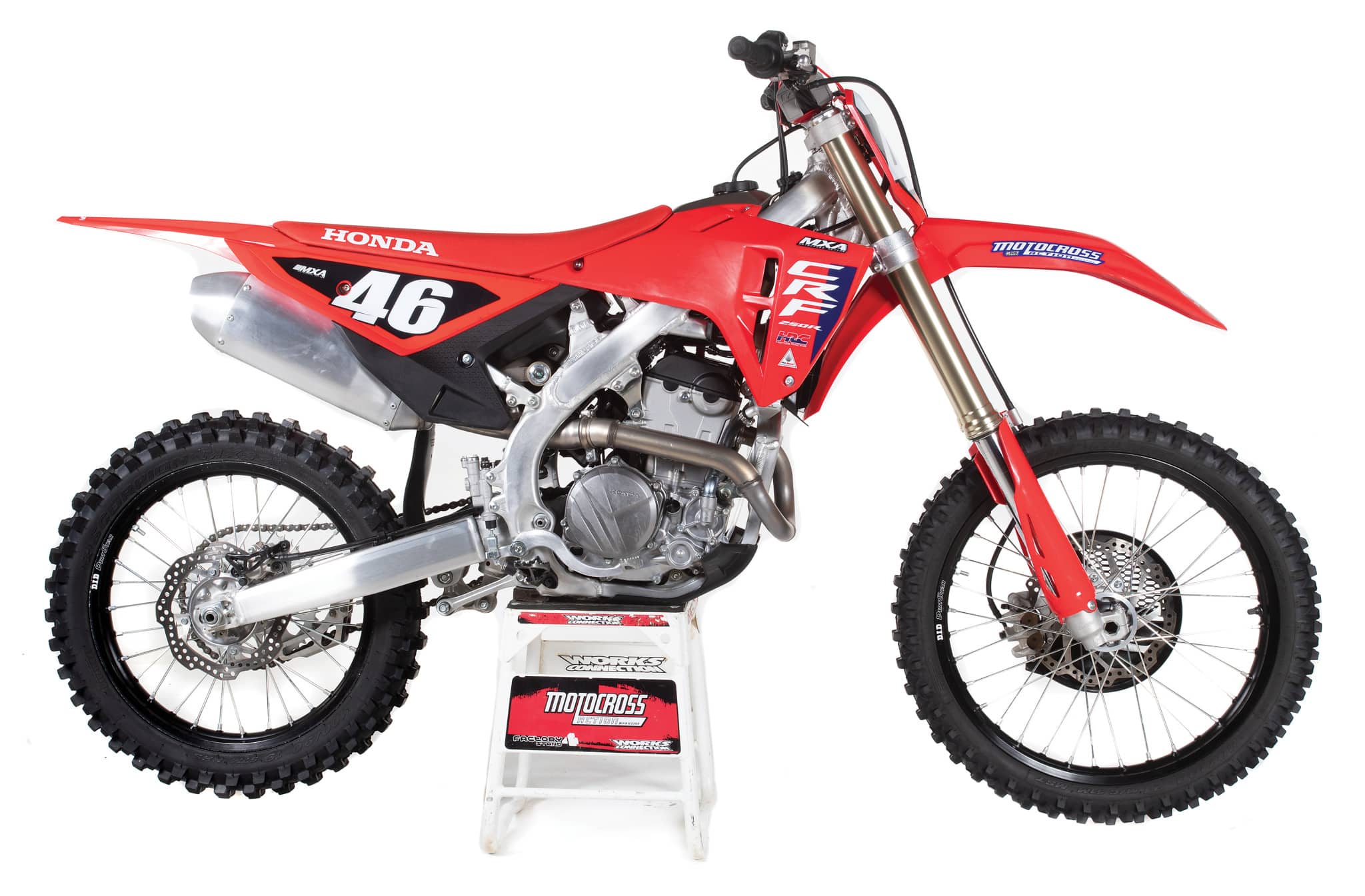 The CRF250 isn’t all new, but it did receive a long list of updates.
The CRF250 isn’t all new, but it did receive a long list of updates.
Q: WHAT’S NEW ON THE 2025 HONDA CRF250 ENGINE?
A: For the last three years we’ve complained about two things—the CRF250’s stiff forks and the CRF250 engine needing more power. Honda could have easily left the engine alone and focused every ounce of energy on the chassis, but thankfully, they did make a few mods to the powerplant. Here’s a list of the powerplant changes:
(1) Airbox. Gone is the upside-down air filter. Now, the filter has a triangle shape, and it’s mounted vertically in a conventional airbox location. The intake is now straighter as well to improve power.
(2) Exhaust. The new system is straighter than before to help broaden the powerband.
(3) Crank. The old CRF250 crank had two hollow cutouts that the factory HRC Honda team used to fill in to increase inertia. Now, the 2025 bike comes stock this way to make the crank slightly heavier and stiffer around the crank pin to reduce flex and improve power.
(4) Mapping. The new CRF250 has the CRF450 map switch and updated mapping.
Q: HOW DOES THE 2025 HONDA CRF250 RUN ON THE DYNO?
A: The dyno is a tool that MXA uses to confirm what we feel on the track. It gives us numerical values to compare brands and helps tuners understand where the bike works well and where it doesn’t. Surprisingly, this bike didn’t run as strong on the dyno as it felt on the track.
Tested against last year’s bike, the 2025 Honda CRF250 is only a hair stronger at the crack of the throttle. Then, it’s almost identical to the 2024 model, only pulling above it slightly through the midrange. On top, the 2025 bike pulls harder, starting at 9200 rpm and peaks at 41.52 horsepower at 12,000 rpm with a peak of 19.95 pound-feet of torque at 9500 rpm.
It is only a 0.8 horsepower improvement at peak with only 0.2 pound-feet more torque at peak. The Austrian 250Fs hit nearly 45 horsepower, and the 2024 Kawasaki KX250 makes 45.11 horsepower on the same dyno. It’s nice that Honda gained (almost) a horsepower, but it still needs more.
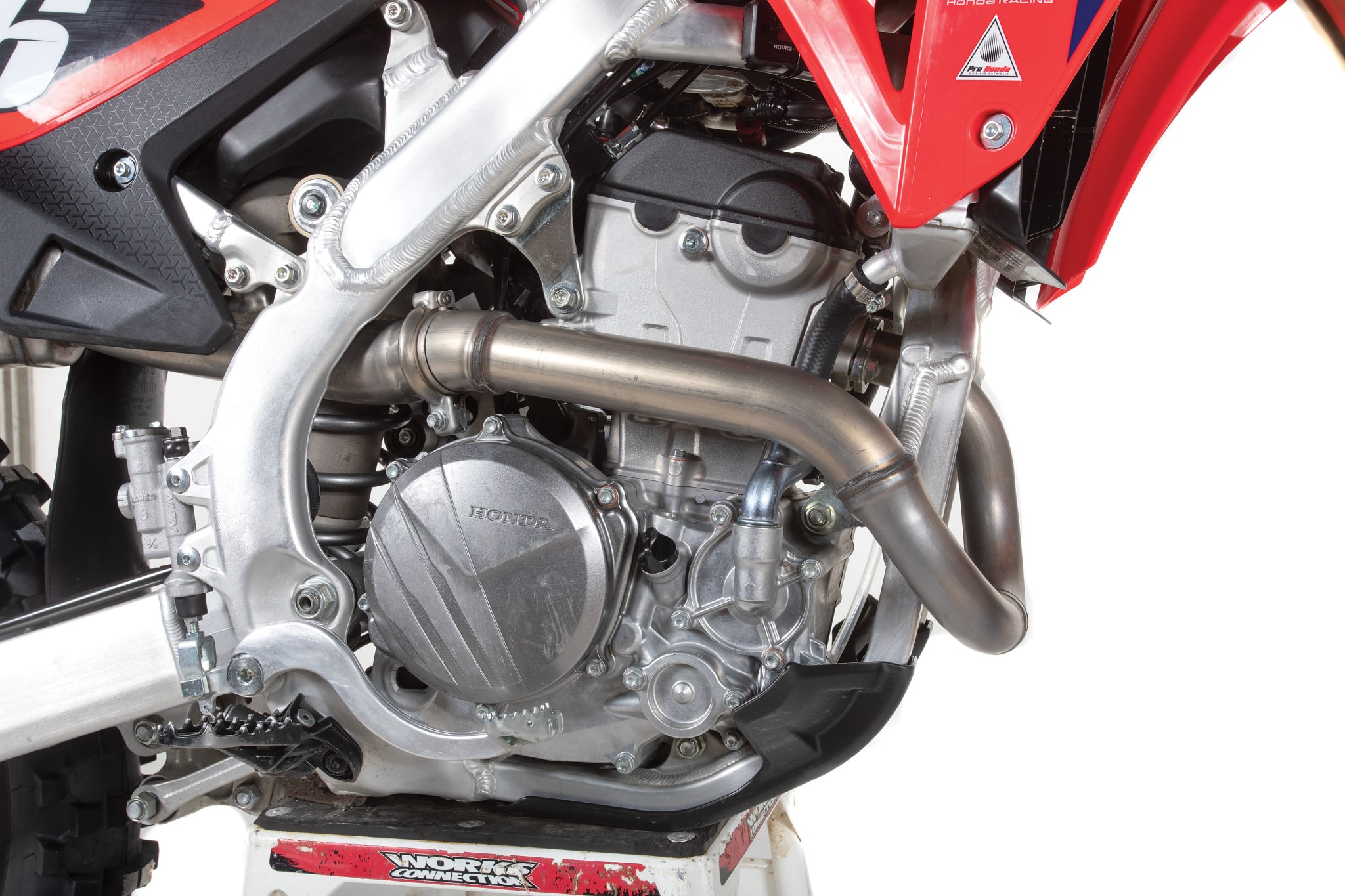 The CRF250 engine looks the same from the outside. On the inside, it has a new crank and improved airflow on the intake and exhaust, boosting dyno numbers by almost one horsepower.
The CRF250 engine looks the same from the outside. On the inside, it has a new crank and improved airflow on the intake and exhaust, boosting dyno numbers by almost one horsepower.
Q: HOW DOES THE 2025 HONDA CRF250 RUN ON THE TRACK?
A: Even though the powerplant wasn’t Honda’s main focus for 2025, we still appreciate that they made the effort to try to improve it. We rode the 2025 and 2024 Honda CRF250s back-to-back to help clarify the differences. Initially, the 2025 model didn’t feel drastically different compared to the 2024. This engine was first introduced in 2022, and with the new crank, airbox, exhaust and mapping, the 2025 CRF250 is improved. The bottom-end snap is strong (not quite as strong as the YZ250F’s) and it needs to be shifted constantly. All of our test riders felt an improvement across the rev range on the new bike. Is it enough to beat Yamaha and KTM in the power department? No. Is it noticeably better? Yes. Usually, we would recommend a gearing change to manipulate the power, but in this instance, we liked the stock 13/50 ratio. It offers a solid throttle response that we don’t want to give up by removing a tooth, and we don’t think it needs an extra tooth either.
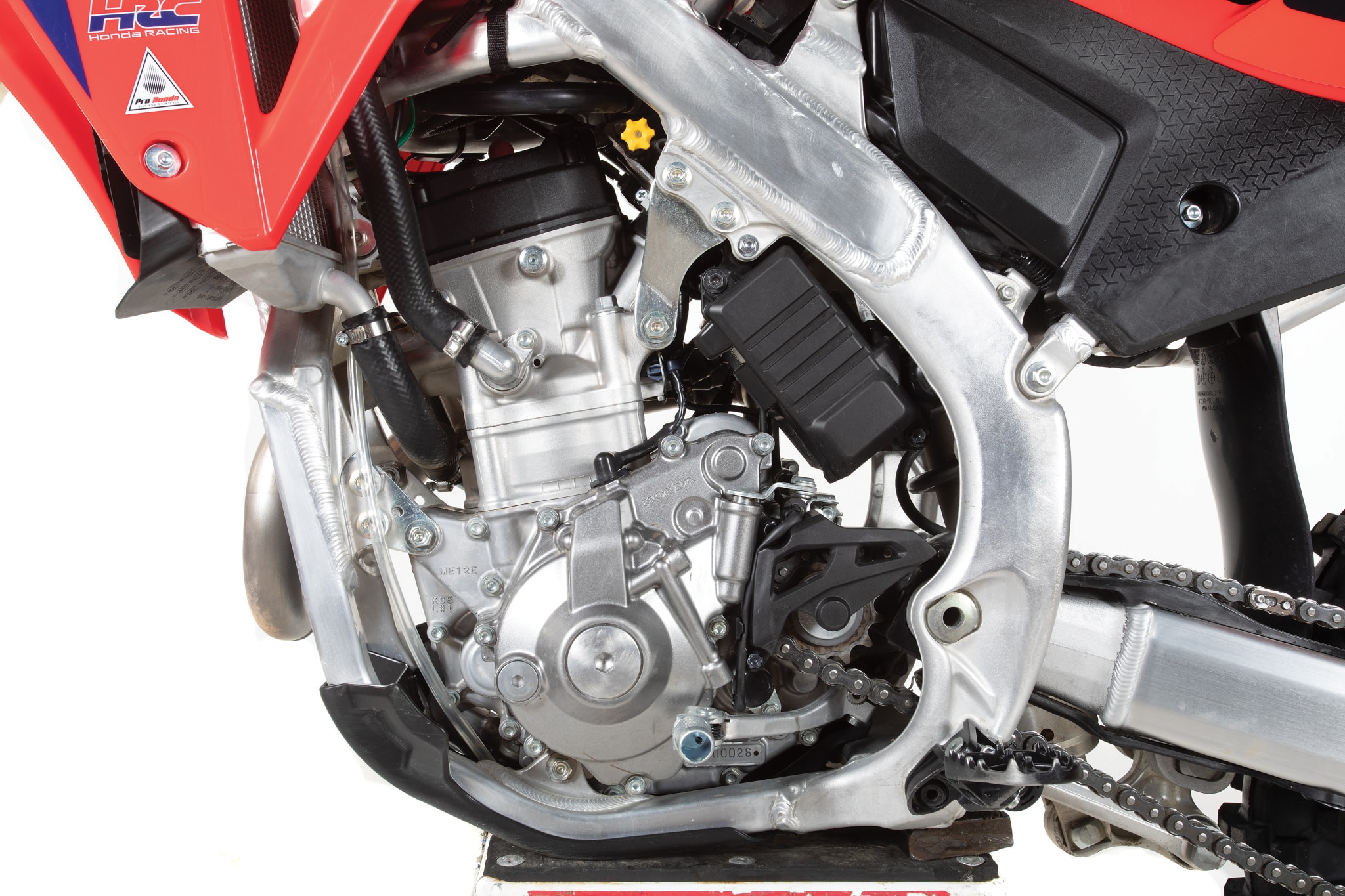 The stock airbox cover breathes great. We removed the filter cover and the filter’s backfire screen, but it didn’t help the dyno numbers.
The stock airbox cover breathes great. We removed the filter cover and the filter’s backfire screen, but it didn’t help the dyno numbers.
Q: HOW IS THE 2025 HONDA SUSPENSION?
A: It was a breath of fresh air to finally enjoy the CRF250 Showa suspension in stock form. The CRF250 has come with ultra-rigid forks for the last three years. From 2018–2021, the bike handled great but had no bottom-end power whatsoever. In 2022, it gained some low-end grunt, but the suspension was a problem. The Showa forks rode high in their stroke and felt comfortable on a smooth track, but as soon as they start compressing in the bumps, they hit a harsh spot you couldn’t get around.
For 2025, Showa and Honda made big swings in the suspension department to match the new chassis. The fork spring rate is still the same at 4.8 N/mm, but the valving and internals are all completely different. As for the shock, the spring rate was lowered from 52 N/mm to 50 N/mm. The shock spring is shorter and lighter, but the shock travel is the same. Additionally, the new shock linkage design and ratio lowered the rear end by 5mm. Although the triple-clamp offset and steering races are the same as in 2024, the slightly lower rear end does affect the rake of the front end, allowing it to slack out a little more.
Thankfully, the new suspension is awesome. Honda worked out the kinks with the chassis and was able to spec suspension with a linear ramp-up of damping in the forks. Our faster test riders felt the suspension was on the soft side, which is to be expected on a stock 250 four-stroke.
We don’t want the OEMs to tailor the stock suspension for AMA pros who are going to turn around and have it re-valved anyway. OEMs must tailor the suspension for the average Joe who doesn’t want to spend time and money fixing the forks.
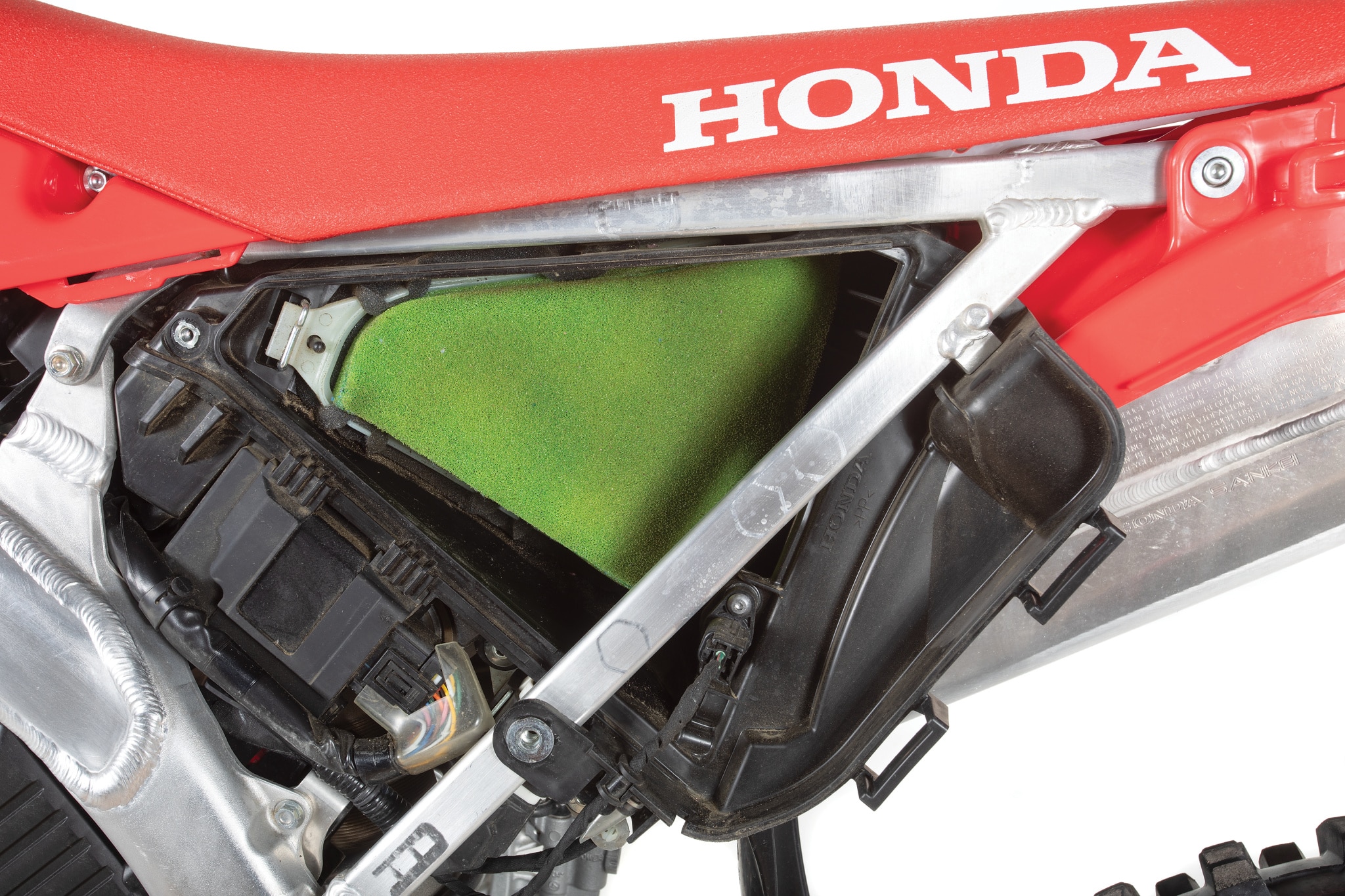 Here’s the new airbox and air filter design.
Here’s the new airbox and air filter design.
Q: WHY DID HONDA MAKE THE NEW FRAME STIFFER?
A: Honda’s strategy for 2025 is a marketing nightmare. The main complaint about the CRF250/450 models is that they were too harsh whenever the track got rough. Talking specifically about the CRF450, the bike would spit you off if you pushed it too hard. Through testing with Jett and Hunter Lawrence and by running their frames through stress tests, Honda determined that their frames weren’t too stiff but too soft! This is a common occurrence in the suspension world. You think your suspension is too stiff because it feels harsh and deflective, so you go softer on the clickers, only to find out your suspension was actually too soft and the harsh feel was from it riding too low in the stroke and bottoming out. Similarly, aluminum frames can work like springs. They reluctantly flex and then snap back into place. This snap is most likely what you feel when you get pitched off the bike without knowing what you did wrong.
Similar to how going stiffer on your clickers can sometimes make your suspension feel softer, Honda going stiffer on the frame makes it feel softer. The frame looks similar from the outside, and the first real noticeable change is the subframe mount being different; however, 70 percent of the components on the frame have been changed, with the main focus being torsional rigidity. In motion, the new bike is much more comfortable than the 2024 model. The suspension valving had to be made softer to complement the frame, triple-clamp, linkage and fork-tube changes.
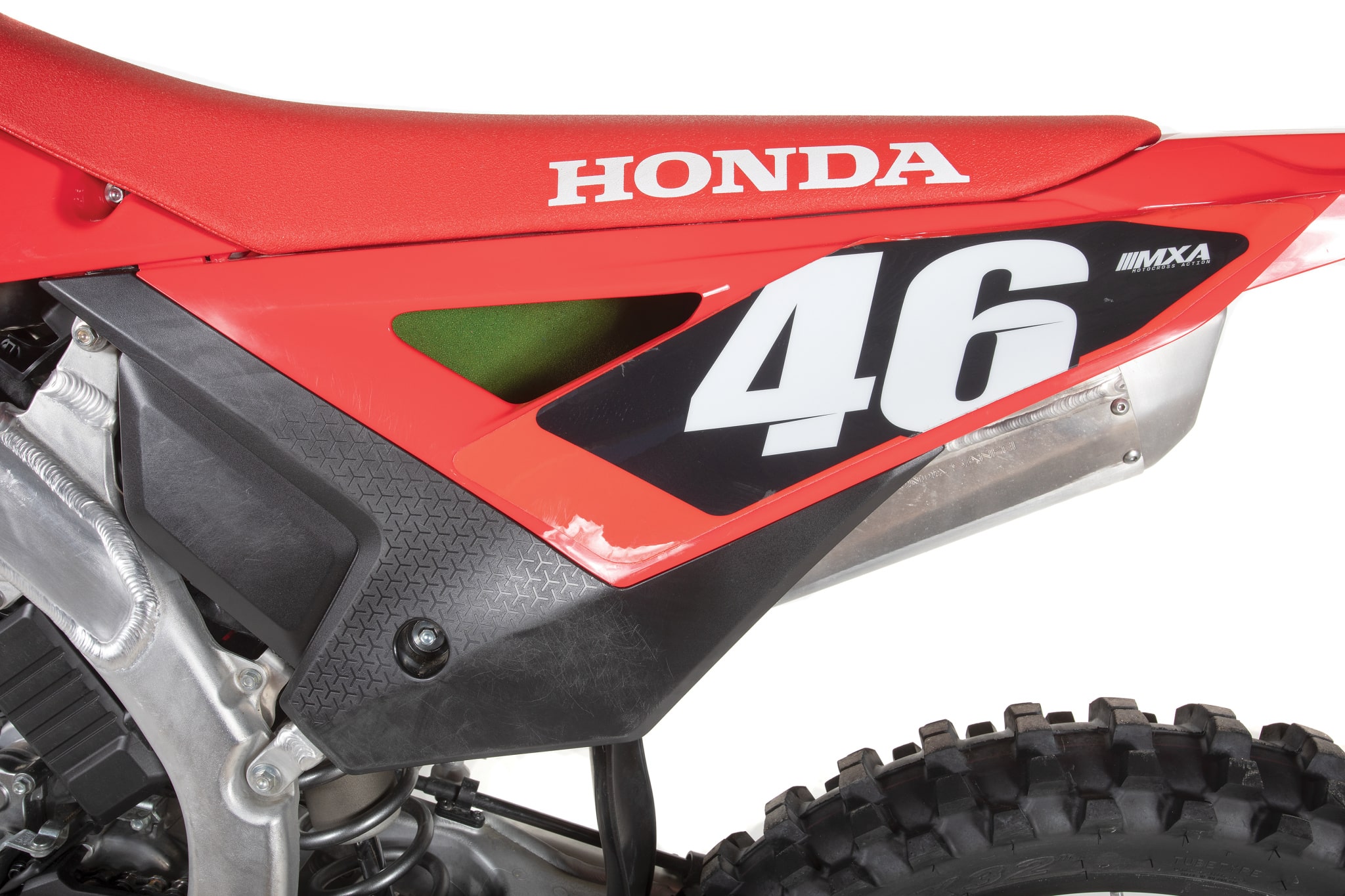 The left-side panel doubles as the number plate and the airbox cover.
The left-side panel doubles as the number plate and the airbox cover.
Q: HOW DOES THE 2024 HONDA CRF250 HANDLE ON THE TRACK?
A: Our test riders felt the new model had less wiggle coming into the turns. The 2024 bike would give a nervous or unsettled feeling on the entrance to corners, making you brake early or chop the throttle. The 2025 model doesn’t wiggle as much when you’re at the end of a straightaway or at tip-in into a turn. This gives the rider more confidence and helps him stay committed. And, if you do make a mistake, it’s easier to recover on the 2025 CRF250.
When it comes to weight and centralizing mass, Honda is one of the best in the business. The way Honda designs the layout of the bike helps to make it feel even lighter on the track. This bike has always been nimble and easy to turn. Also, compared to the other brands, the CRF250 is easier to scrub and whip than the YZ250F, 250SXF, KX250, FC250, RMZ250, and MC250F. One example of centralizing mass for 2025 is Honda moving the ECU from down under the airbox and behind the mud flap to right next to the airbox. Of course, it’s a safety and durability advantage as well, because the old location was horrible for mud and dirt. Honda’s battery location is another example of centralized mass; it’s above the countershaft sprocket in a black box on the Honda, while all the other brands position their battery under the seat.
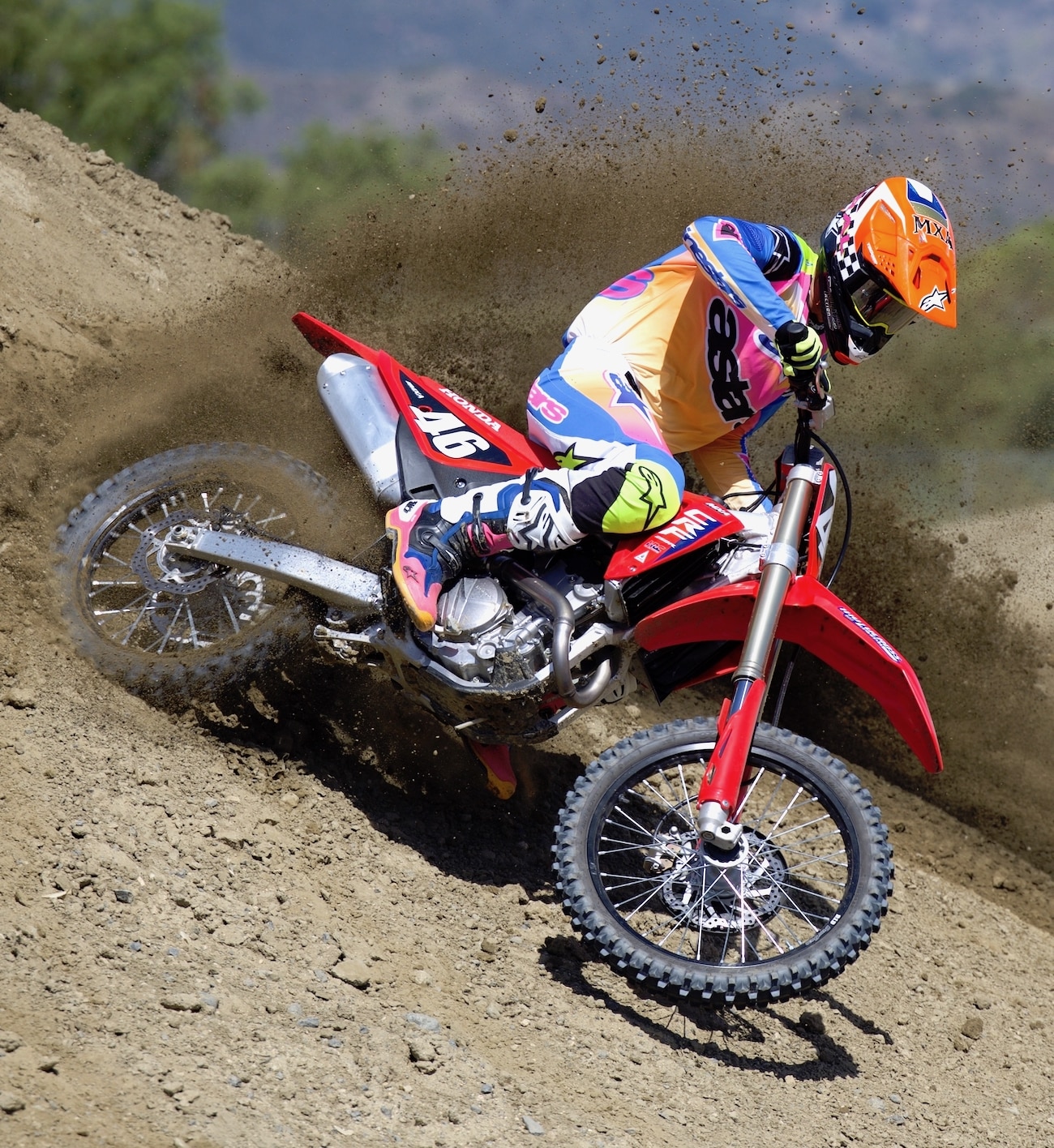 The CRF250 is still a nimble machine.
The CRF250 is still a nimble machine.
Q: HOW ARE THE ERGONOMICS?
A: Ergonomics do play a part in how a bike handles. Honda has long been praised for having the best rider triangle, and that didn’t change; however, the shape of the rear end did change. When Jett and Hunter Lawrence came off the dual-exhaust 2021 CRF250 onto the all-new 2022 model, their first complaint was about the rear end being too skinny and difficult to hang onto. Over the past three seasons, we’ve seen HRC Honda add all kinds of grip tape and additional brackets under the side number panels to give them something to grip with their legs. The new 2025 bodywork changes were inspired by the Lawrence brothers. The bike is slightly wider in the midpoint where your knees grip, and the shrouds are extended for more surface area to grip onto.
Our test riders weren’t so picky about the rear end on the previous platform, but they immediately noticed the difference between the two bikes when going back to back. The 2025 bodywork gives you much more surface area for your legs to grip onto. One gripe about the new shrouds: our taller testers got their legs caught on the top of them in the deep ruts.
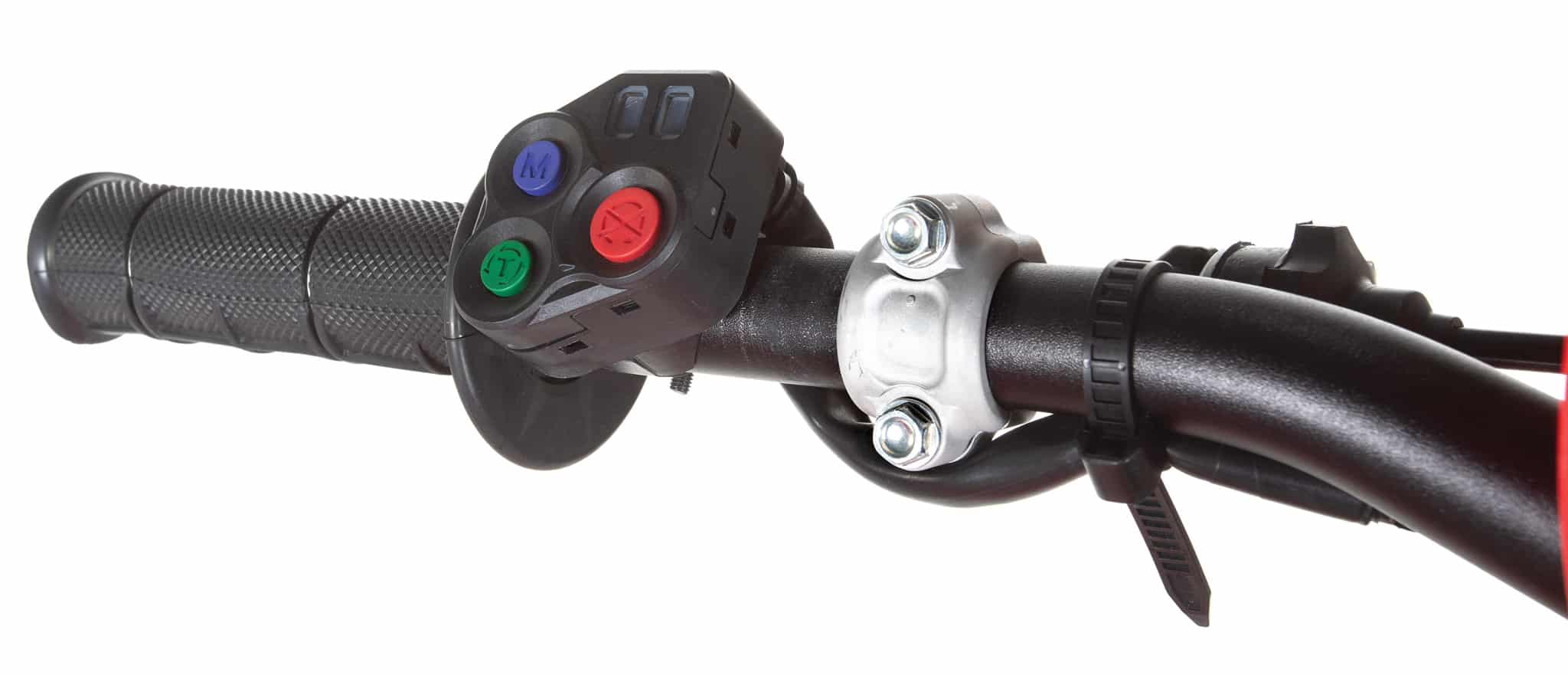 Honda shares this same map switch with Kawasaki.
Honda shares this same map switch with Kawasaki.
Q: WHAT DID WE HATE?
A: The hate list.
(1) Tires. The Pirelli MX32 100/90-19 rear tire saves weight but loses traction.
(2) Sound. Unfortunately, the stock CRF250 muffler still sounds like it’s blown out.
(3) Radiator cap. Switch out the stock 1.1 kg/mm2 radiator with a 1.8 Twin Air high-pressure radiator cap to protect your engine.
(4) Grips. The stock grips feel like they are made out of wood.
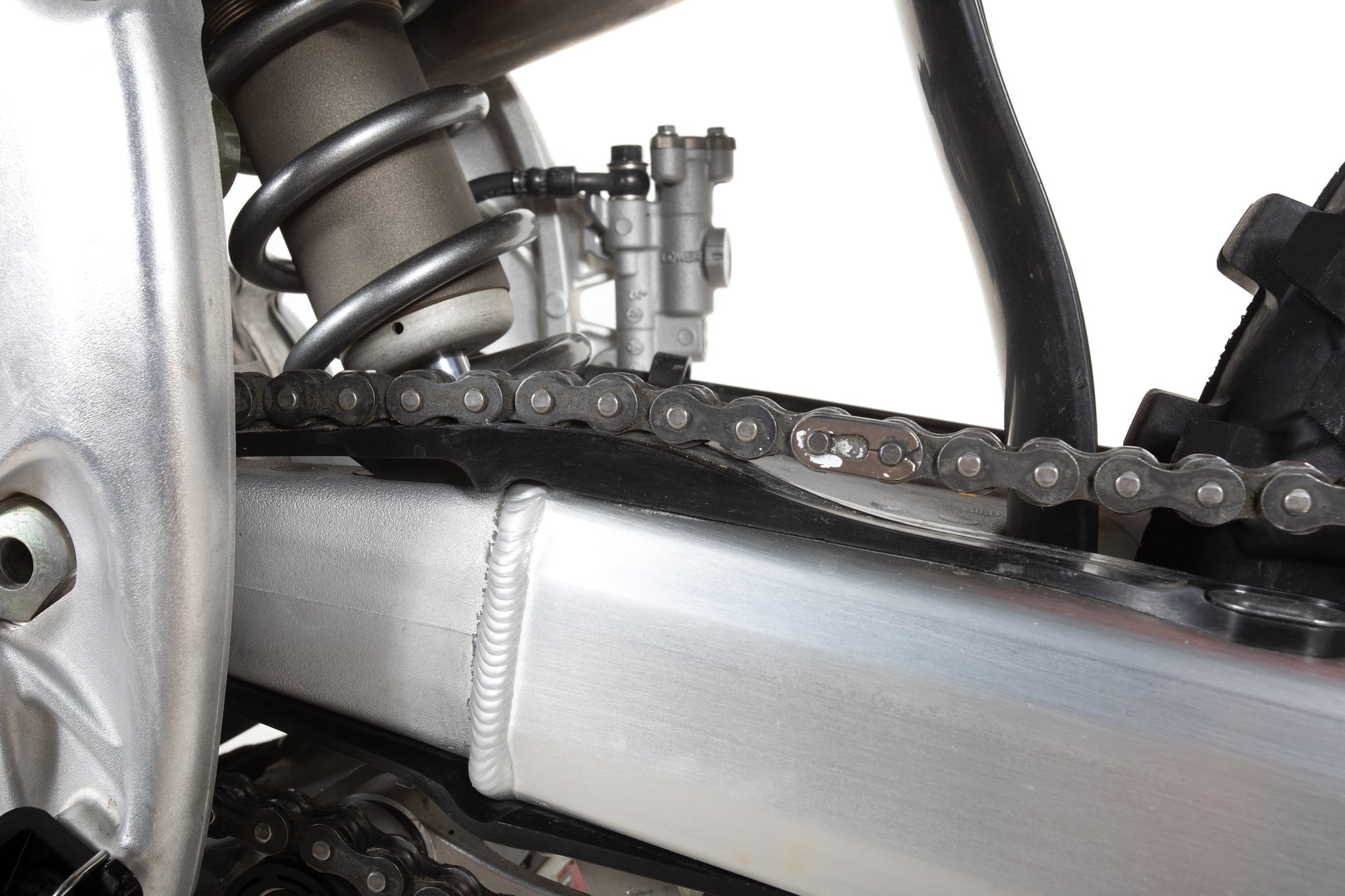 Honda claims the hump in the chain slider helps optimize chain torque.
Honda claims the hump in the chain slider helps optimize chain torque.
Q: WHAT DID WE LIKE?
A: The like list.
(1) Price. Normally, OEMs use big updates to hike the price; we’re glad it’s only $8299.
(2) Engine. We appreciate that the CRF250 is easy to ride and that it gained some power on top for 2025.
(3) Weight. The Honda CRF250 feels extremely light on the track.
(4) Front brake. The updated front brake is nice. Not all of our test riders felt a difference, but our picky testers felt the new front brake didn’t surge as much.
(5) Shock. We love how easy it is to remove the shock now. You don’t have to loosen and raise the subframe anymore.
(6) Skid plate. The lightweight, flexible plastic skid plate is nice.
(7) Bodywork. We love the new side number plates.
(8) Airbox. We never came to terms with Honda’s upside-down air filter. The 2025 CRF250 has a new airbox design that has the air filter mounted where it is normally found.
Q: WHAT DID WE REALLY THINK?
A: Over the last three years, the Showa forks and the engine were our two main complaints. Of course, buyers could always pay the aftermarket to re-valve the forks and hop up the engine, but isn’t that what they were paying Honda to do for them in the first place?
Coming into this test, we were skeptical about how much better the 2025 Honda CRF250 would be. To our surprise, it got a lot better! No, it’s not an all-new bike. No, it’s not anywhere near as fast as the fastest bikes, but the suspension and chassis are 10 times better. Honda took what they had and made it better in all areas.
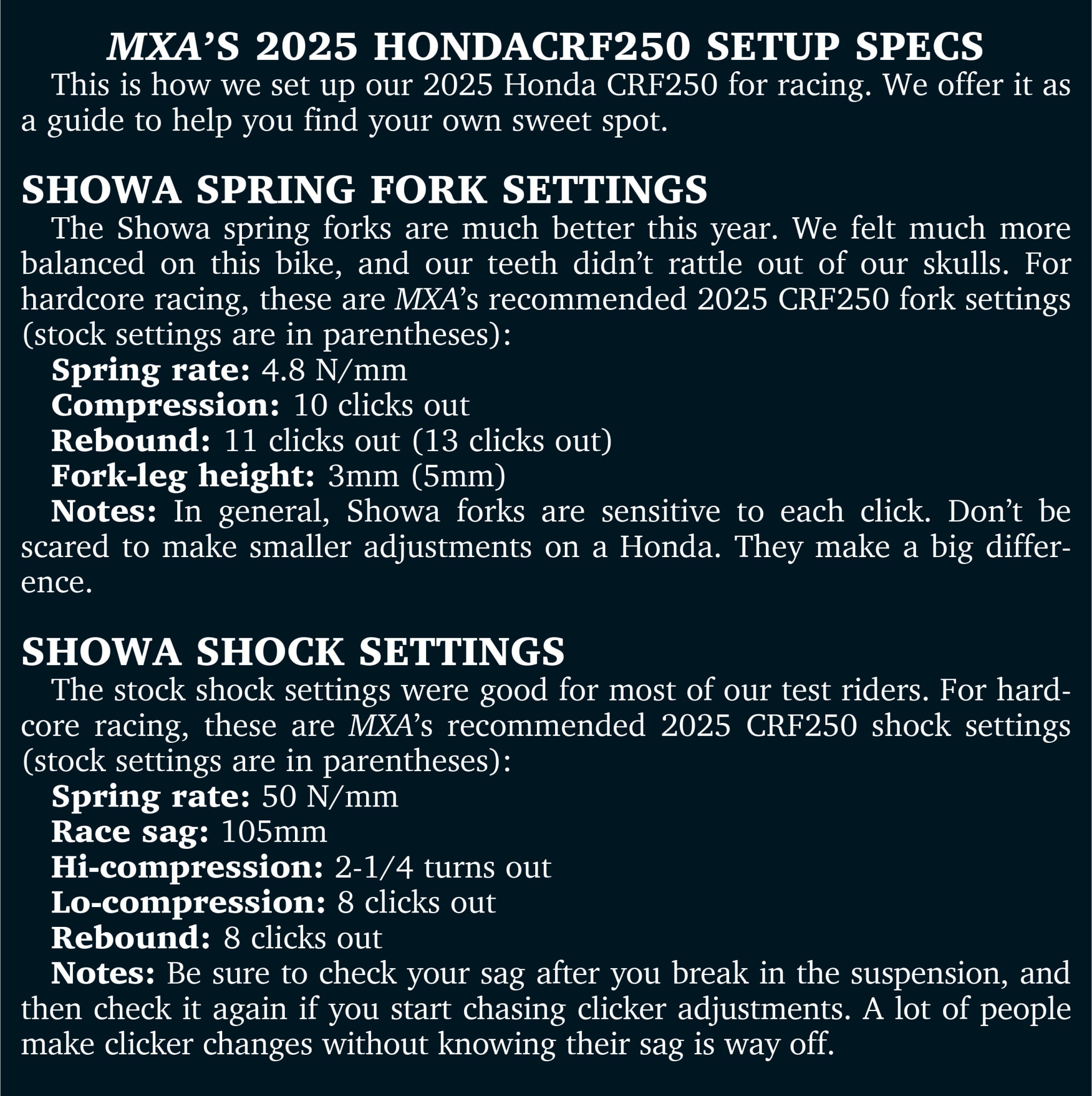




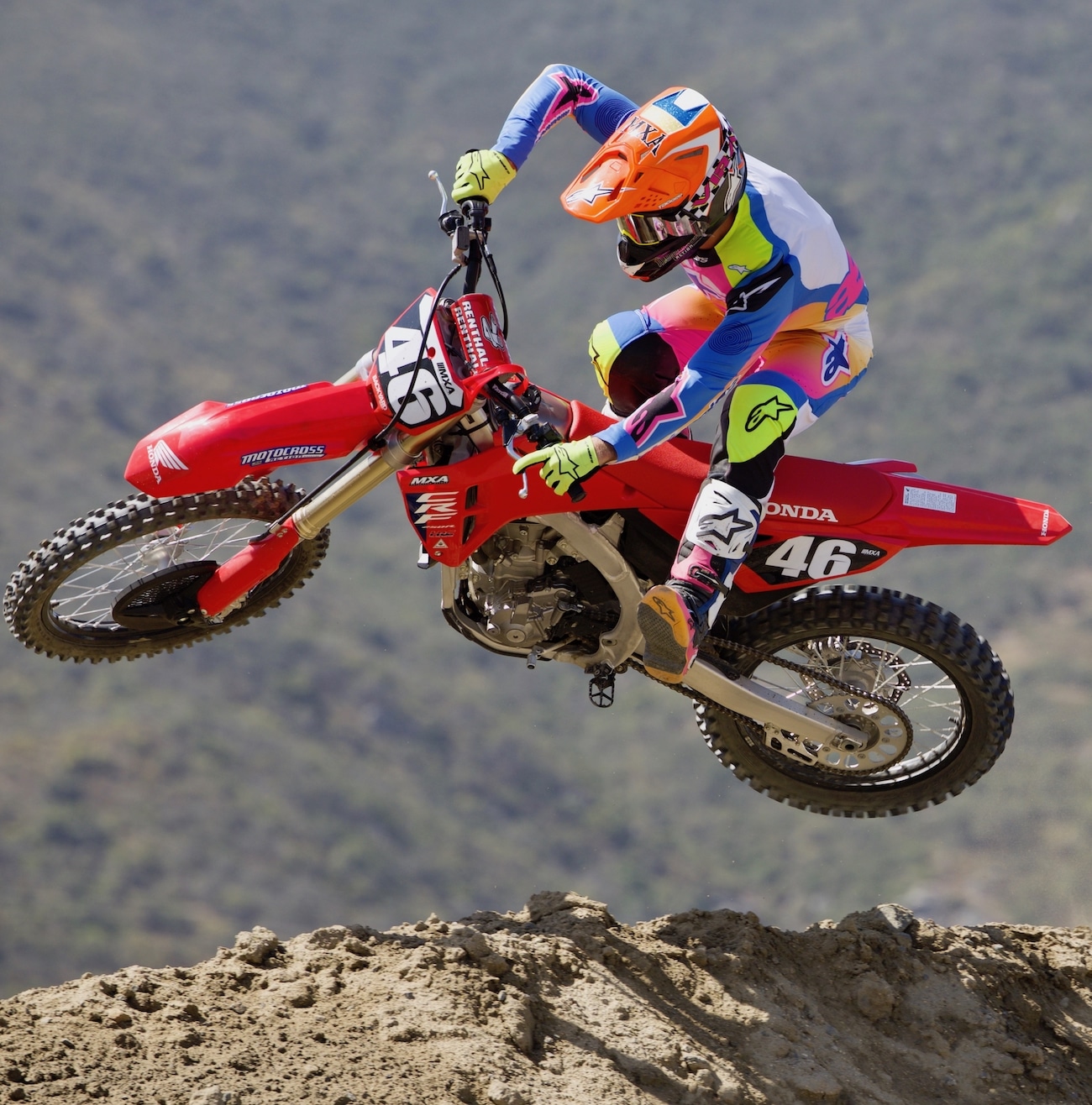


Comments are closed.